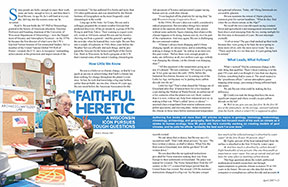
The Faithful Heretic
A Wisconsin
Icon Pursues Tough Questions
Some people are lucky enough to enjoy their
work, some are lucky enough to love it, and then there’s
Reid Bryson. At age 86, he’s still hard at it every day,
delving into the science some say he invented.
Reid A. Bryson holds the 30th PhD in Meteorology
granted in the history of American education. Emeritus Professor
and founding chairman of the University of Wisconsin Department
of Meteorology—now the Department of Oceanic and Atmospheric
Sciences—in the 1970s he became the first director of
what’s now the UW’s Gaylord Nelson Institute of
Environmental Studies. He’s a member of the United Nations
Global 500 Roll of Honor—created, the U.N. says, to recognize
“outstanding achievements in the protection and improvement
of the environment.” He has authored five books and more
than 230 other publications and was identified by the British
Institute of Geographers as the most frequently cited climatologist
in the world.
Long ago in the Army Air Corps, Bryson and
a colleague prepared the aviation weather forecast that predicted
discovery of the jet stream by a group of B-29s flying to and
from Tokyo. Their warning to expect westerly winds at 168 knots
earned Bryson and his friend a chewing out from a general—and
the general’s apology the next day when he learned they
were right. Bryson flew into a couple of typhoons in 1944, three
years before the Weather Service officially did such things,
and he prepared the forecast for the homeward flight of the
Enola Gay. Back in Wisconsin, he built a program at the UW that’s
trained some of the nation’s leading climatologists.
How Little We Know
Bryson is a believer in climate change, in
that he’s as quick as anyone to acknowledge that Earth’s
climate has done nothing but change throughout the planet’s
existence. In fact, he took that knowledge a big step further,
earlier than probably anyone else. Almost 40 years ago, Bryson
stood before the American Association for the Advancement of
Science and presented a paper saying human activity could alter
climate.
“I was laughed off the platform for saying
that,” he told Wisconsin Energy Cooperative News.
In the 1960s, Bryson’s idea was widely
considered a radical proposition. But nowadays things have turned
almost in the opposite direction: Hardly a day passes without
some authority figure claiming that whatever the climate happens
to be doing, human activity must be part of the explanation.
And once again, Bryson is challenging the conventional wisdom.
“Climate’s always been changing
and it’s been changing rapidly at various times, and so
something was making it change in the past,” he told us
in an interview this past winter. “Before there were enough
people to make any difference at all, two million years ago,
nobody was changing the climate, yet the climate was changing,
okay?”
“All this argument is the temperature
going up or not, it’s absurd,” Bryson continues.
“Of course it’s going up. It has gone up since the
early 1800s, before the Industrial Revolution, because we’re
coming out of the Little Ice Age, not because we’re putting
more carbon dioxide into the air.”
Little Ice Age? That’s what chased the
Vikings out of Greenland after they’d farmed there for
a few hundred years during the Mediaeval Warm Period, an earlier
run of a few centuries when the planet was very likely warmer
than it is now, without any help from industrial activity in
making it that way. What’s called “proxy evidence”—assorted
clues extrapolated from marine sediment cores, pollen specimens,
and tree-ring data—helps reconstruct the climate in those
times before instrumental temperature records existed.
We ask about that evidence, but Bryson says
it’s second-tier stuff. “Don’t talk about
proxies,” he says. “We have written evidence, eyeball
evidence. When Eric the Red went to Greenland, how did he get
there? It’s all written down.”
Bryson describes the navigational instructions
provided for Norse mariners making their way from Europe to
their settlements in Greenland. The place was named for a reason:
The Norse farmed there from the 10th century to the 13th, a
somewhat longer period than the United States has existed. But
around 1200 the mariners’ instructions changed in a big
way. Ice became a major navigational reference. Today, old Viking
farmsteads are covered by glaciers.
Bryson mentions the retreat of Alpine glaciers,
common grist for current headlines. “What do they find
when the ice sheets retreat, in the Alps?”
We recall the two-year-old report saying a
mature forest and agricultural water-management structures had
been discovered emerging from the ice, seeing sunlight for the
first time in thousands of years. Bryson interrupts excitedly.
“A silver mine! The guys had stacked
up their tools because they were going to be back the next spring
to mine more silver, only the snow never went,” he says.
“There used to be less ice than now. It’s just getting
back to normal.”
What Leads, What Follows?
What is normal? Maybe continuous change is
the only thing that qualifies. There’s been warming over
the past 150 years and even though it’s less than one
degree, Celsius, something had to cause it. The usual suspect
is the “greenhouse effect,” various atmospheric
gases trapping solar energy, preventing it being reflected back
into space.
We ask Bryson what could be making the key
difference:
Q: Could you rank the things
that have the most significant impact and where would you put
carbon dioxide on the list?
A: Well let me give you one
fact first. In the first 30 feet of the atmosphere, on the average,
outward radiation from the Earth, which is what CO2 is supposed
to affect, how much [of the reflected energy] is absorbed by
water vapor? In the first 30 feet, 80 percent, okay?
Q: Eighty percent of the
heat radiated back from the surface is absorbed in the first
30 feet by water vapor…
A: And how much is absorbed
by carbon dioxide? Eight hundredths of one percent. One one-thousandth
as important as water vapor. You can go outside and spit and
have the same effect as doubling carbon dioxide.
This begs questions about the widely publicized
mathematical models researchers run through supercomputers to
generate climate scenarios 50 or 100 years in the future. Bryson
says the data fed into the computers overemphasizes carbon dioxide
and accounts poorly for the effects of clouds—water vapor.
Asked to evaluate the models’ long-range predictive ability,
he answers with another question: “Do you believe a five-day
forecast?”
Bryson says he looks in the opposite direction,
at past climate conditions, for clues to future climate behavior.
Trying that approach in the weeks following our interview, Wisconsin
Energy Cooperative News soon found six separate papers about
Antarctic ice core studies, published in peer-reviewed scientific
journals between 1999 and 2006. The ice core data allowed researchers
to examine multiple climate changes reaching back over the past
650,000 years. All six studies found atmospheric carbon dioxide
concentrations tracking closely with temperatures, but with
CO2 lagging behind changes in temperature, rather than leading
them. The time lag between temperatures moving up—or down—and
carbon dioxide following ranged from a few hundred to a few
thousand years.
Renaissance Man, Marathon Man
When others were laughing at the concept, Reid
Bryson was laying the ground floor for scientific investigation
of human impacts on climate. We asked UW Professor Ed Hopkins,
the assistant state climatologist, about the significance of
Bryson’s work in advancing the science he’s now
practiced for six decades.
“His contributions are manifold,”
Hopkins said. “He wrote Climates of Hunger back in the
1970s looking at how climate changes over the last several thousand
years have affected human activity and human cultures.”
This, he suggests, is traceable to Bryson’s
high-school interest in archaeology, followed by college degrees
in geology, then meteorology, and studies in oceanography, limnology,
and other disciplines. “He’s looked at the interconnections
of all these things and their impact on human societies,”
Hopkins says. “He’s one of those people I would
say is a Renaissance person.”
The Renaissance, of course, produced its share
of heretics, and 21 years after he supposedly retired, one could
ponder whether Bryson’s work today is a tale of continuing
heresy, or of conventional wisdom being outpaced by an octogenarian.
Without addressing—or being asked—that
question, UW Green Bay Emeritus Professor Joseph Moran agrees
that Bryson qualifies as “the father of the science of
modern climatology.”
“In his lifetime, in his career, he has
shaped the future as well as the present state of climatology,”
Moran says, adding, “We’re going to see his legacy
with us for many generations to come.”
Holding bachelor’s and master’s
degrees from Boston College, Moran became a doctoral candidate
under Bryson in the late 1960s and early ’70s. “I
came to Wisconsin because he was there,” Moran told us.
With Hopkins, Moran co-authored Wisconsin’s
Weather and Climate, a book aimed at teachers, students, outdoor
enthusiasts, and workers with a need to understand what the
weather does and why. Bryson wrote a preface for the book but
Hopkins told us the editors “couldn’t fathom”
certain comments, thinking he was being too flippant with the
remark that “Wisconsin is not for wimps when it comes
to weather.”
Clearly what those editors couldn’t
fathom was that Bryson simply enjoys mulling over the reasons
weather and climate behave as they do and what might make them—and
consequently us—behave differently. This was immediately
obvious when we asked him why, at his age, he keeps showing
up for work at a job he’s no longer paid to do.
“It’s fun!” he said. Ed Hopkins
and Joe Moran would undoubtedly agree.
“I think that’s one of the reasons
for his longevity,” Moran says. “He’s so interested
and inquisitive. I regard him as a pot-stirrer. Sometimes people
don’t react well when you challenge their long-held ideas,
but that’s how real science takes place.”—Dave
Hoopman


















